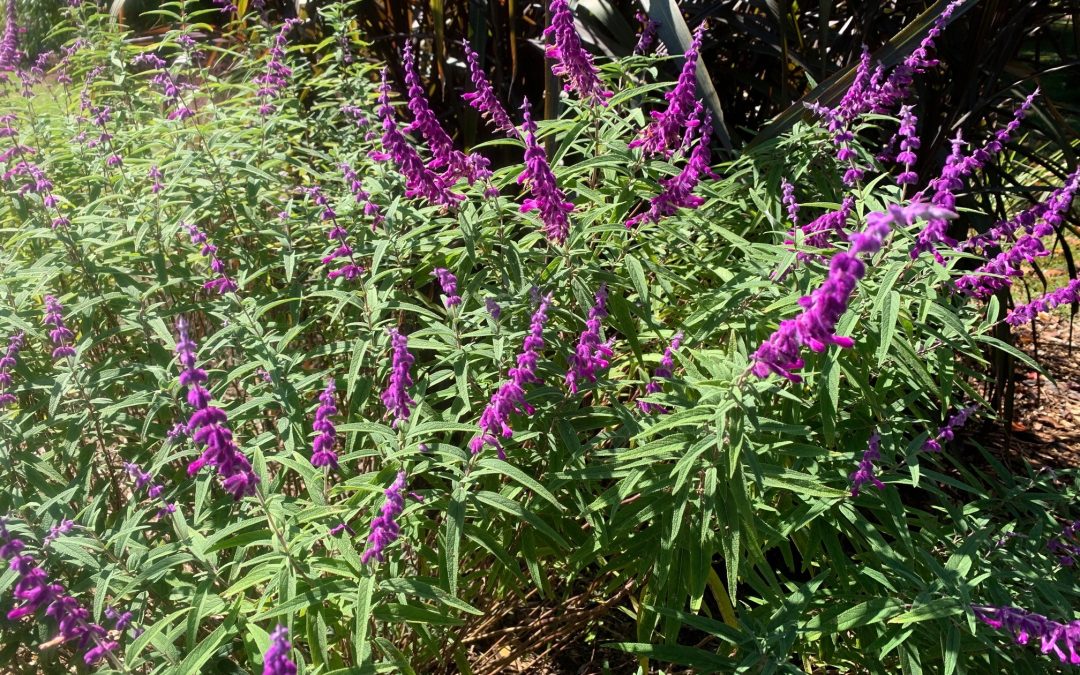
by Beth Bolles | Aug 20, 2024
Salvias are a popular group of plants for attracting pollinators and adding lots of color to the landscape. A unique salvia that offers velvety flowers is the Mexican bush sage, Salvia leucantha.
In our heat, Mexican bush sage can tolerate partial shade and likes average water with well drained soils. Plants will not overtake a spot only growing 2-4 feet. The velvety portion of the flower is a purple calyx with the flower petals emerging white or purple. Flower stalks will extend above the foliage to be available to many bees, butterflies, and hummingbirds.
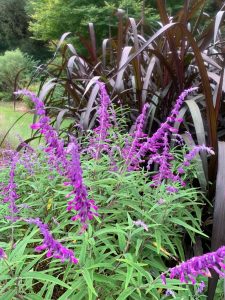
Mexican bush sage planted with ‘First Knight’ pennisetum. Photo by Bolles, UF IFAS Extension Escambia County.
During cold winters, plants can die back to the ground but often return each spring. It is always good to take a few cuttings for new plant starts just in case your plant dies back from heavy rains or drought conditions.
Mexican bush sage can be an accent plant in your garden or used in a small mass of 2-3 plants. Consider adding it with contrasting textures and colors so later summer flowers are easily visible.
by Beth Bolles | Jun 7, 2018
There is one tough annual plant that thrives in the summer garden and provides bright color in our sun and heat. Portulaca or moss rose (Portulaca grandiflora) is strong performer, even growing well when reseeding in sidewalk cracks and stone walkways. Of course it will be most attractive when used in containers or well drained landscape beds in bright sunshine.
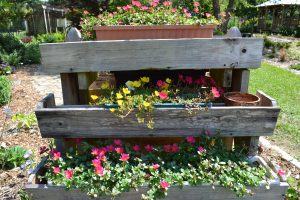
Containers of portulaca brighten an entrance to the herb garden at Escambia County Extension Demonstration Gardens. Photo by Beth Bolles, UF IFAS Extension Escambia County
The thicker, flattened leaves of portulaca make is adaptable to drier conditions. The plants are only about 6 inches tall but branches will spread out a foot or so from the center. The attractive flowers extend just above attractive green foliage in colors of yellow, pinks, and oranges. Portulaca is extremely versatile, making it a good filler in a container or at the edges of flower beds along hardscape areas.
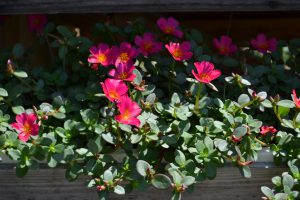
Bright flowers of portulaca reach for the sun. Photo by Beth Bolles, UF IFAS Extension Escambia County
Portulaca will not perform the best when soils remain too moist or days stay overcast for extended periods. Flowering will also be reduced if water is totally lacking. Maintain a balance by providing a quality soil that drains well.
Although many gardeners prefer perennials to annuals, portulaca can provide a big impact in the summer garden for a small investment.
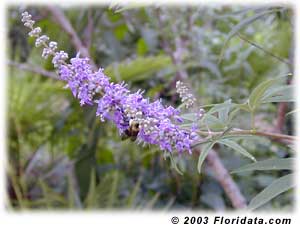
by Sheila Dunning | Jun 22, 2016
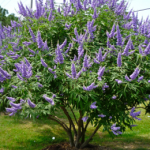 The showy chaste tree makes an attractive specimen as the centerpiece of your landscape bed or in a large container on the deck. Easy-to-grow, drought resistant, and attractive to butterflies and bees, Vitex agnus-castus is a multi-stemmed small tree with fragrant, upwardly-pointing lavender blooms and gray-green foliage. The chaste tree’s palmately divided leaves resemble those of the marijuana (Cannabis sativa) plant; its flowers can be mistaken for butterfly bush (Buddleia sp.); and the dry, darkened drupes can be used for seasoning, similar to black pepper, making it a conversation piece for those unfamiliar with the tree.
The showy chaste tree makes an attractive specimen as the centerpiece of your landscape bed or in a large container on the deck. Easy-to-grow, drought resistant, and attractive to butterflies and bees, Vitex agnus-castus is a multi-stemmed small tree with fragrant, upwardly-pointing lavender blooms and gray-green foliage. The chaste tree’s palmately divided leaves resemble those of the marijuana (Cannabis sativa) plant; its flowers can be mistaken for butterfly bush (Buddleia sp.); and the dry, darkened drupes can be used for seasoning, similar to black pepper, making it a conversation piece for those unfamiliar with the tree.
Vitex, with its sage-scented leaves that were once believed to have a sedative effect, has the common name “Chastetree” since Athenian women used the leaves in their beds to keep themselves chaste during the feasts of Ceres, a Roman festival held on April 12. In modern times, the tree is more often planted where beekeepers visit in order to promote excellent honey production or simply included in the landscape for the enjoyment of its showy, summer display of violet panicles.
Chaste tree is native to woodlands and dry areas of southern Europe and western Asia. It will thrive in almost any soil that has good drainage, prefers full sun or light shade, and can even tolerate moderate salt air. Vitex is a sprawling plant that grows 10-20 feet high and wide, that looks best unpruned. If pruning is desired to control the size, it should be done in the winter, since it is a deciduous tree and the blooms form on new wood. The chaste tree can take care of itself, but can be pushed to faster growth with light applications of fertilizer in spring and early summer and by mulching around the plant. There are no pests of major concern associated with this species, but, root rot can cause decline in soils that are kept too moist.
by Mary Salinas | Aug 23, 2013
Add the easy-to-grow garden nasturtium to your vegetable or flower garden!
Dress up a ho-hum salad with a vibrant blossom or two just like some of the high-end restaurants. The first taste you experience will be sweetness and then a pleasant peppery flavor emerges. Not only can you eat the flowers but the leaves can also be tossed into your salad and the immature seed pods can be pickled and eaten similar to capers.
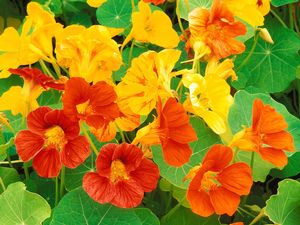
Photo courtesy of the Mendocino Coast Botanical Garden
Garden nasturtium, known to botanists as Tropaeolum majus, is an annual that originated in the Andes of South America. Seed and plants are commonly found in garden centers, although a greater variety is available when purchased from seed catalogues or online. A variety of cultivars are available, from dwarf bushy types to climbing or trailing types. Perky blooms in vivid shades of orange, yellow, pink and red are often produced in abundance.
This annual is easy and fast to grow from seed. If transplanting from small potted plants, make sure not to disturb the delicate root system during the transplant process. Give them partial to full sun and regular watering, even though they are drought tolerant. They prefer a lighter, sandy, well-drained soil and don’t perform as well in dense, rich soils. Be careful with the fertilizer as too much nitrogen will produce lots of green foliage but few blooms.
[warning]Aphids like to feast on the succulent flowers and foliage as well, so be diligent in scouting for this pest. Control is usually adequate by dislodging them with a spray of water or insecticidal soap. Insecticidal soap will cause the aphid to try out and dessicate. Be careful to spray the undersides of the leaves as well for complete control. Make sure to apply products that are safe for food crops and follow all label instructions.[/warning]
In the Florida panhandle, garden nasturtium can be a part of the garden year-round. However, they generally decline and stop flowering with the onset of the full brunt of the summer heat unless a bit of afternoon shade is available. When planted late in the fall, they are susceptible to frost damage but often will recover.
.
For more information from the University of Florida, please see:
Garden Nasturtium, Tropaeoleum majus L.
Gardening in a Minute: Nasturtium








